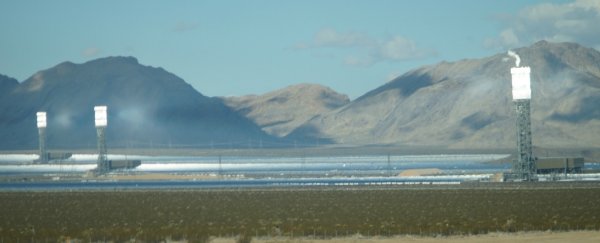A rare and unusual type of solar power plant that concentrates sunlight in California is accidentally killing up to 6,000 birds every year, with staff reporting that the birds keep flying into its concentrated beams of sunlight, and spontaneously bursting into flames.
The problem has been going on since the site opened in 2014, and the team says it's trying everything to save the birds from a fiery fate. But so far, the perfect solution has eluded them.
"We're doing everything we can to reduce the number of birds killed out here," the plant's spokesman, David Knox, told Louis Sahagun at the LA Times. "If there's a silver bullet out there, maybe we'll find it."
The sight of a bird being fried to death is so common at the Ivanpah Solar Plant in California's Mojave Desert, that workers have nicknamed the smouldering birds "streamers", because they leave tiny wisps of white smoke behind as they burn up in the sky.
So why is this happening?
Well, it's mainly due to the plant's overall design and location. Unlike typical solar farms that use photovoltaic panels on a large scale, the site at Ivanpah is built on entirely different principles. To catch sunlight, the plant uses 5 square miles (12.9 square kilometres) of giant mirrors that focus beams of concentrated sunlight onto three different 40-storey-tall towers.
Once the beams are focused on the towers, their energy can be used to power turbines inside, which generates energy for the power grid.
The problem is that all this concentrated light around the towers makes them a prime location for insects to hang around, and this attracts the birds. When the birds cross in front of all that concentrated light to get at the insects, they burn up in seconds.
And the situation is made even worse by the fact that the plant sits along the Pacific Flyway - a popular migratory route for many different types of birds, including protected species like varied thrushes and northern goshawks.
According to Sahagun, federal biologists estimate that upwards of 6,000 birds perish at the plant every year, and even though officials at the facility say they're trying to come up with a solution, little has changed since its launch in 2014.
"Ivanpah is a bird sink - and [a] cautionary tale unfolding on public lands," Garry George from Audubon California - a conservation group that focuses on the Pacific Flyway - told the LA Times. "It continues to operate as though there's an endless supply of birds to burn."
To make matters worse, some of the deterrent systems in place to keep other animals out of the facility have caused unforeseen repercussions. The plant installed a large fence to keep out endangered desert tortoises, but the knock-on effect is that this has made it way easier for coyotes to kill roadrunners.
The good news for the roadrunners is that the Ivanpah team says it plans on adding 'roadrunner doors' to the fences so they can easily hop through, instead of getting trapped.
Birds in the sky, on the other hand, are a little more complicated, because how do you stop a bird from flying wherever it wants?
With no easy solution in sight, the US Fish and Wildlife Service and other federal agencies are stepping in to collaborate on potential solutions.
"It may take another nine months of data to determine what is actually going on at Ivanpah in terms of bird mortalities and the effectiveness of various deterrents," deputy chief of the US Fish and Wildlife Service's migratory bird program, Amedee Bricky, told the LA Times.
"Eventually, we hope to transport what we learn to nations around the world developing their own solar energy programs."
What makes this problem stand out - besides the large number of deaths - is that it shows that even solar power plants, which are supposed to be beneficial for the environment, can still have unforeseen impacts on local ecosystems.
Hopefully, with so many teams now working on the problem, a solution will soon present itself.
Until then, it's not looking too great for birds along the Pacific Flyway.
Editor's note (9 September 2019): Coverage of the Ivanpah bird problem has contributed to the unfounded misconception that solar panels may kill birds. We have clarified this article to explain how the solar thermal plant differs from the far more common design used in photovoltaic solar farms.
